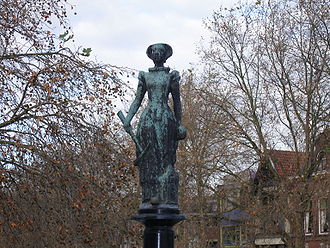
Trijn van de Leemput
Encyclopedia

Spain
Spain , officially the Kingdom of Spain languages]] under the European Charter for Regional or Minority Languages. In each of these, Spain's official name is as follows:;;;;;;), is a country and member state of the European Union located in southwestern Europe on the Iberian Peninsula...
. According to local legend in Utrecht, she led a large group of women on May 2, 1577 to the castle of Vredenburg
Vredenburg (castle)
Vredenburg or Vredeborch was a 16th-century castle built by Habsburg emperor Charles V in the city of Utrecht in the Netherlands. Some remains of the castle, which stood for only 50 years, are still visible on what is now Vredenburg square in Utrecht....
and gave the signal to begin demolishing the castle.
The castle of Vredenburg had been built by emperor Charles V
Charles V, Holy Roman Emperor
Charles V was ruler of the Holy Roman Empire from 1519 and, as Charles I, of the Spanish Empire from 1516 until his voluntary retirement and abdication in favor of his younger brother Ferdinand I and his son Philip II in 1556.As...
after annexing Utrecht in 1528, and was manned by a Spanish garrison. On November 8, 1576 the Pacification of Ghent
Pacification of Ghent
The Pacification of Ghent, signed on November 8, 1576, was an alliance of the provinces of the Habsburg Netherlands for the purpose of driving mutinying Spanish mercenary troops from the country, and at the same time a peace treaty with the rebelling provinces Holland and Zeeland.-Background:In...
was signed and the Eighty Years' War began. The Dutch rebels besieged the Vredenburg fortress. However, following negotiations, the garrison abandoned the castle after only a few months, in February 1577.
The citizens of Utrecht demanded that the abandoned castle be demolished, but the city government would not allow it, so on May 2 the Utrechters, led by Trijn van Leemput, took matters into their own hands. The events that followed were recorded by contemporaries Arnold Buchelius
Aernout van Buchel
Aernout van Buchel was a Dutch antiquarian and humanist, specialising in Genealogy and Heraldry.-Life:...
(1565–1641) and Joh. van Beverwyck (1594–1647). Later historians have cast doubt on the historical accuracy of the tale. Most likely it is part legend and partly based on fact.
Trijn van Leemput is said to have gathered a large group of women and marched on the castle, carrying a makeshift banner made out of a blue apron tied to a broom. At the castle, she signalled for the demolishment to begin by removing some bricks from the castle walls. The other Utrechters followed suit, and began breaking down the walls using axes, hammers and pick-axes.
She is also said to have fought two Spanish soldiers, who were lodged at her house, at an earlier occasion. After catching them stealing, she threw one down the stairs and threatened the other with a knife.
Archival research has shown that Trijn van Leemput really existed and was born around 1530, probably near Vreeswijk
Vreeswijk
Vreeswijk is a former village and municipality in the Dutch province of Utrecht. The municipality merged with Jutphaas in 1971, and is now the southern half of the town of Nieuwegein....
. She and her husband, brewer and miller Jan Jacob van Leemput, moved into a large house on the Oudegracht
Oudegracht
The Oudegracht, or "old canal", runs through the center of Utrecht, the Netherlands. It starts in the southeast of the city. Here the Kromme Rijn and the Vaartse Rijn arrive to meet the original moat of the fortified town, and the Oudegracht goes from there...
canal in Utrecht in 1555. The family was one of the city's most prominent families. Trijn's husband was a guild leader and member of the city government, and was one of the four deputies who negotiated with William the Silent
William the Silent
William I, Prince of Orange , also widely known as William the Silent , or simply William of Orange , was the main leader of the Dutch revolt against the Spanish that set off the Eighty Years' War and resulted in the formal independence of the United Provinces in 1648. He was born in the House of...
on the conditions for Utrecht's entry into the Pacification of Ghent
Pacification of Ghent
The Pacification of Ghent, signed on November 8, 1576, was an alliance of the provinces of the Habsburg Netherlands for the purpose of driving mutinying Spanish mercenary troops from the country, and at the same time a peace treaty with the rebelling provinces Holland and Zeeland.-Background:In...
, the Dutch coalition against Spain.
As early as the 17th century, Trijn van Leemput was depicted in various paintings. A statue of her, pick-axe in hand, was erected on Zandbrug bridge, near her home, in 1955.
Sources
- Instituut voor Nederlandse geschiedenis (Dutch)
- De Dom Digitaal (Dutch)

